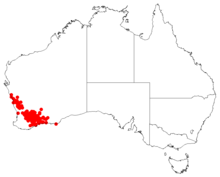Hakea cygna
Hakea cygna, commonly known as the swan hakea,[2] is usually a dense shrub endemic to Western Australia with creamy-white upright flowers appearing from July to August.
| Hakea cygna | |
|---|---|
 | |
| Hakea cygna subsp. cygna near Tathra National Park | |
| Scientific classification | |
| Kingdom: | Plantae |
| Clade: | Tracheophytes |
| Clade: | Angiosperms |
| Clade: | Eudicots |
| Order: | Proteales |
| Family: | Proteaceae |
| Genus: | Hakea |
| Species: | H. cygna |
| Binomial name | |
| Hakea cygna Lamont[1] | |
 | |
| Occurrence data from Australasian Virtual Herbarium | |
Description
Hakea cygna is an upright non-lignotuberous shrub growing to 0.4–2 m (1–7 ft) high. The smaller branches are densely covered in flattened silky hairs at flowering time. The leaves are variable, they may be flat and thick, narrowly egg-shaped widest in the middle, more or less needle-shaped or triangular in cross-section. Leaves are smooth 2–7.5 cm (0.79–3.0 in) long and 1.2–9 mm (0.047–0.35 in) wide with prominent veins on the leaf margin. The upper side of the leaves has 1-3 obscure longitudinal veins, the underside veins barely visible. The inflorescence consists of 6-14 creamy-white flowers in racemes, appearing upright and singly in leaf axils. The cream-white pedicels are smooth, rarely with soft short flattened hairs. The perianth a cream-white and the style is 5.5–7 mm (0.22–0.28 in) long. The oval to egg-shaped fruit are 2.1–3.7 cm (0.83–1.5 in) long and 1.2–2 cm (0.47–0.79 in) wide growing at an angle on a short thick stalk. The fruit is barely beaked but has a short prominent point. The seed are pale brown with darker streaks are broadly egg-shaped to almost triangular or circular and 12–20 mm (0.47–0.79 in) long. Flowers appear either from May to June or August to September.[2][3][4][5][6]
Taxonomy and naming
Hakea cygna was first formally described by Byron Barnard Lamont in 1987 and published in the Botanical Journal of the Linnean Society.[1] The specific epithet (cygna) is derived from the Latin word cygnus meaning "swan",[2][7] referring to the shape of the fruit believed to resemble that of a swan. Two subspecies of Hakea cygna have been recognised.
- Hakea cygna subsp. cygna has flat, thick, linear to narrowly egg-shaped leaves 2.5–9 mm (0.098–0.35 in) wide. Restricted to an area south of Lake King.
- Hakea cygna subsp. needlei has variable leaves either narrowly linear, needle-shaped or triangular in cross-section and 1.2–2 mm (0.047–0.079 in) wide.
Distribution and habitat
Hakea cygna is widely distributed from Geraldton to Ravensthorpe in the south-east and east to Cape Arid. Grows in heath or mallee-heath on gravelly loams, sandy loams, white yellow or grey sand, often over laterite.[3]
Conservation status
Hakea cygna subsp. needlei is classified as "Priority Two" by the Western Australian Government Department of Parks and Wildlife[5] meaning that it is poorly known and from only one or a few locations.[8]
References
- "Hakea cygna". APNI. Australian National Herbarium. Retrieved 26 February 2019.
- Young, Jennifer (2006). "Hakeas of Western Australia:A Field and Identification Guide". J A Young. ISBN 0-9585778-2-X.
- Wilson (ed), Annette; Barker, Robyn M.; Haegi, Laurence A.; Barker, William R. (1999). "Flora of Australia" Volume 17B Proteaceae 3 Hakeas to Dryandra (PDF). Canberra/Melbourne: ABRS-Department of Environment & Heritage. ISBN 0-643-06454-0.CS1 maint: extra text: authors list (link)
- Holliday, Ivan (2005). "Hakeas a Field and Garden Guide". Reed New Holland. ISBN 1-877069-14-0.
- "Hakea cygna". FloraBase. Western Australian Government. Retrieved 26 February 2019.
- Archer, William. "Hakea cygna". Esperance Wildflowers. Retrieved 26 February 2019.
- Brown, Roland Wilbur (1956). The Composition of Scientific Words. Washington, D.C.: Smithsonian Institution Press. p. 248.
- "Conservation codes for Western Australian Flora and Fauna" (PDF). Government of Western Australia Department of Parks and Wildlife. Retrieved 26 February 2019.
| Taxon identifiers |
|---|